
A funeral is a ceremony connected with the final disposition of a corpse, such as a burial or cremation, with the attendant observances. Funerary customs comprise the complex of beliefs and practices used by a culture to remember and respect the dead, from interment, to various monuments, prayers, and rituals undertaken in their honour. Customs vary between cultures and religious groups. Funerals have both normative and legal components. Common secular motivations for funerals include mourning the deceased, celebrating their life, and offering support and sympathy to the bereaved; additionally, funerals may have religious aspects that are intended to help the soul of the deceased reach the afterlife, resurrection or reincarnation.
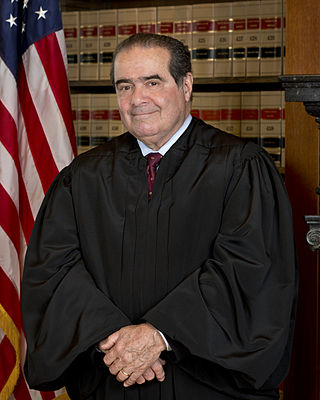
Antonin Gregory Scalia was an American jurist who served as an associate justice of the Supreme Court of the United States from 1986 until his death in 2016. He was described as the intellectual anchor for the originalist and textualist position in the U.S. Supreme Court's conservative wing. For catalyzing an originalist and textualist movement in American law, he has been described as one of the most influential jurists of the twentieth century, and one of the most important justices in the history of the Supreme Court. Scalia was posthumously awarded the Presidential Medal of Freedom in 2018, and the Antonin Scalia Law School at George Mason University was named in his honor.

Joan Ruth Bader Ginsburg was an American lawyer and jurist who served as an associate justice of the Supreme Court of the United States from 1993 until her death in 2020. She was nominated by President Bill Clinton to replace retiring justice Byron White, and at the time was viewed as a moderate consensus-builder. Ginsburg was the first Jewish woman and the second woman to serve on the Court, after Sandra Day O'Connor. During her tenure, Ginsburg authored the majority opinions in cases such as United States v. Virginia (1996), Olmstead v. L.C. (1999), Friends of the Earth, Inc. v. Laidlaw Environmental Services, Inc. (2000), and City of Sherrill v. Oneida Indian Nation of New York (2005). Later in her tenure, Ginsburg received attention for passionate dissents that reflected liberal views of the law. She was popularly dubbed "the Notorious R.B.G.", a moniker she later embraced.

Douglas Howard Ginsburg is an American lawyer, jurist, and academic who serves as a senior judge on the U.S. Court of Appeals for the District of Columbia Circuit. He was appointed to the D.C. Circuit in 1986 by President Ronald Reagan, and he served as its chief judge from 2001 to 2008.

A catafalque is a raised bier, box, or similar platform, often movable, that is used to support the casket, coffin, or body of a dead person during a Christian funeral or memorial service. Following a Roman Catholic Requiem Mass, a catafalque may be used to stand in place of the body at the absolution of the dead or used during Masses of the Dead and All Souls' Day.
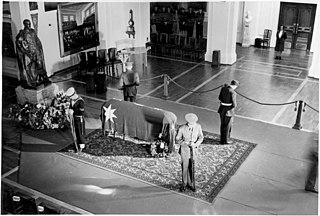
A state funeral is a public funeral ceremony, observing the strict rules of protocol, held to honour people of national significance. State funerals usually include much pomp and ceremony as well as religious overtones and distinctive elements of military tradition. Generally, state funerals are held in order to involve the general public in a national day of mourning after the family of the deceased gives consent. A state funeral will often generate mass publicity from both national and global media outlets.
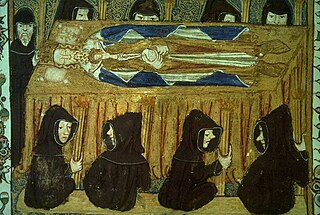
Lying in state is the tradition in which the body of a deceased official, such as a head of state, is placed in a state building, either outside or inside a coffin, to allow the public to pay their respects. It traditionally takes place in a major government building of a country, state, or city. While the practice differs among countries, in the United States, a viewing in a location other than a government building, such as a church, may be referred to as lying in repose. It is a more formal and public kind of wake or viewing. Lying in state often precedes a state funeral.

On June 5, 2004, Ronald Reagan, the 40th president of the United States, died after having Alzheimer's disease for nearly a decade. Reagan was the first former U.S. president to die in 10 years since Richard Nixon in 1994. At the age of 93 years, 120 days, Reagan was the longest-lived U.S. president in history at the time of his death, a record which was surpassed by Gerald Ford on November 12, 2006. His seven-day state funeral followed. After Reagan's death, his body was taken from his Bel Air home to the Kingsley and Gates Funeral Home in Santa Monica, California, to prepare the body for burial. On June 7, Reagan's casket was transported by hearse and displayed at the Ronald Reagan Presidential Library in Simi Valley, California, then flown to Washington, D.C., on June 9 for a service, public viewing and tributes at the U.S. Capitol.

In death customs, a viewing is the time that family and friends come to see the deceased before the funeral, once the body has been prepared by a funeral home. It is generally recommended that a body first be embalmed to create the best possible presentation of the deceased. A viewing may take place at the funeral parlor, in a family home or at a place of worship, such as a church. Some cultures, such as the Māori of New Zealand, often take the body to the marae or tribal community hall.
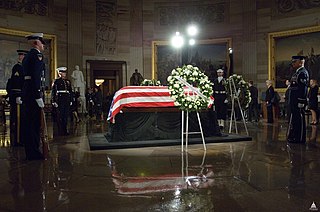
On December 26, 2006, Gerald Ford, the 38th president of the United States, died at his home in Rancho Mirage, California at 6:45 p.m. local time. At 8:49 p.m. local time, President Ford's wife of 58 years, Betty Ford, issued a statement that confirmed his death: "My family joins me in sharing the difficult news that Gerald Ford, our beloved husband, father, grandfather and great-grandfather has passed away at 93 years of age. His life was filled with love of God, his family and his country." The causes of death listed on the subsequent death certificate were arteriosclerotic cerebrovascular disease and diffuse arteriosclerosis.

The Lincoln catafalque is a catafalque hastily constructed in 1865 to support the casket of Abraham Lincoln while the president's body lay in state in the Capitol Rotunda in Washington, D.C. The catafalque has since been used for all those who have lain in state in the Capitol Rotunda. When not in use, the catafalque is kept in the United States Capitol in a small vaulted chamber. It was previously kept in an area called Washington's Tomb, which was originally intended, but never used, as the burial place for George Washington, the first President of the United States.

Tangihanga, or more commonly, tangi, is a traditional funeral rite practised by the Māori people of New Zealand. Tangi were traditionally held on marae, and are still strongly associated with the tribal grounds, but are now also held at homes and funeral parlours. While still widely practised, tangi are not universally observed, and some tribes have expressed concerns about lower numbers of tangi.
Speculation abounded over potential nominations to the Supreme Court of the United States by Ronald Reagan even before his presidency officially began, due to the advanced ages of several justices, and Reagan's own highlighting of Supreme Court nominations as a campaign issue. Reagan had promised "to appoint only those opposed to abortion and the 'judicial activism' of the Warren and Burger Courts". Conversely, some opposed to Reagan argued that he could "appoint as many as five Justices" and would "use the opportunity to stack the Court against women, minorities and social justice".

In the United States, state funerals are the official funerary rites conducted by the federal government in the nation's capital, Washington, D.C., that are offered to a sitting or former president, a president-elect, high government officials and other civilians who have rendered distinguished service to the nation. Administered by the Military District of Washington (MDW), a command unit of the Joint Force Headquarters National Capital Region, state funerals are greatly influenced by protocol, steeped in tradition, and rich in history. However, the overall planning as well as the decision to hold a state funeral, is largely determined by a president and their family.
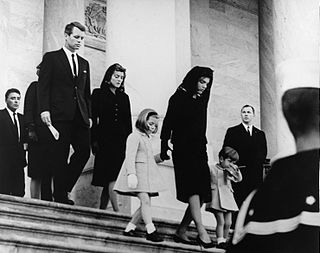
The state funeral of U.S. President John F. Kennedy took place in Washington, D.C., during the three days that followed his assassination on Friday, November 22, 1963, in Dallas, Texas.
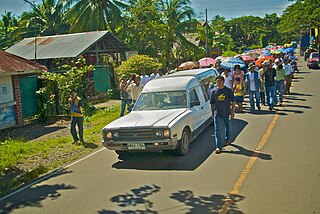
During the Pre-Hispanic period the early Filipinos believed in a concept of life after death. This belief, which stemmed from indigenous ancestral veneration and was strengthened by strong family and community relations within tribes, prompted the Filipinos to create burial customs to honor the dead through prayers and rituals. Due to different cultures from various regions of the Philippines, many different burial practices have emerged. For example, the Manobos buried their dead in trees, the Ifugaos seated the corpse on a chari before it was brought to a cave and buried elsewhere. The most common forms of traditional burials are supine pits, earthenware jars, and log coffins, and have been a topic of interest among Philippine archaeologists since the early 20th century.

In the United Kingdom, state funerals are usually reserved for monarchs. The most recent was the state funeral of Queen Elizabeth II on 19 September 2022.

A mourning portrait or deathbed portrait is a portrait of a person who has recently died, usually shown on their deathbed, or lying in repose, displayed for mourners. These were not rare in European homes of well-to-do people as a way of remembering and honoring the dead. People were generally laid out in their best clothes with some sort of special headdress, and some sort of token in their hands. Today these portraits give insights into old funeral customs, but also various types of information regarding folk costumes. In the 19th century post-mortem photography continued the tradition.

St. Joseph's Catholic Church, also commonly known as St. Joseph's on Capitol Hill, is a parish of the Roman Catholic Church in the Capitol Hill neighborhood of Washington, D.C., in the Archdiocese of Washington. The church is located less than half a mile from the United States Capitol Building and United States Supreme Court Building.

Ruth Bader Ginsburg, Associate Justice of the Supreme Court of the United States, died from complications of metastatic pancreatic cancer on September 18, 2020, at the age of 87. Her death received immediate and significant public attention; a vigil at the Supreme Court plaza in Washington, D.C., was held that same evening. Memorials and vigils were held in several U.S. cities, including Chicago, New York City, and San Francisco.




















